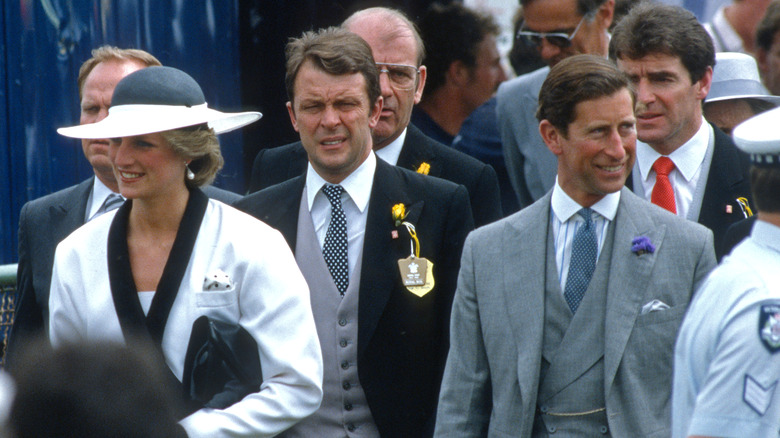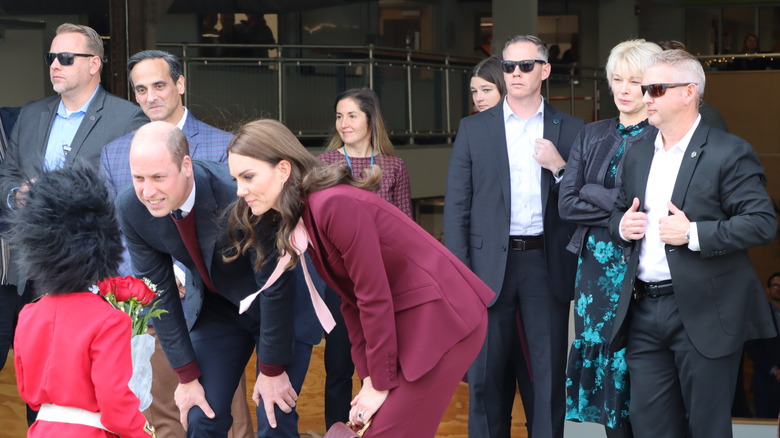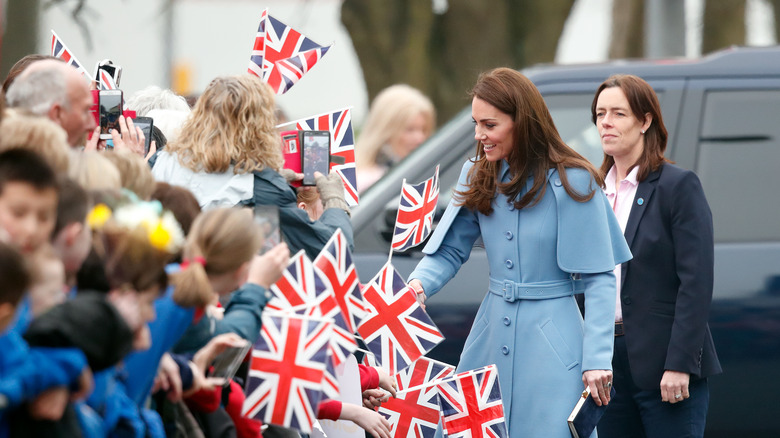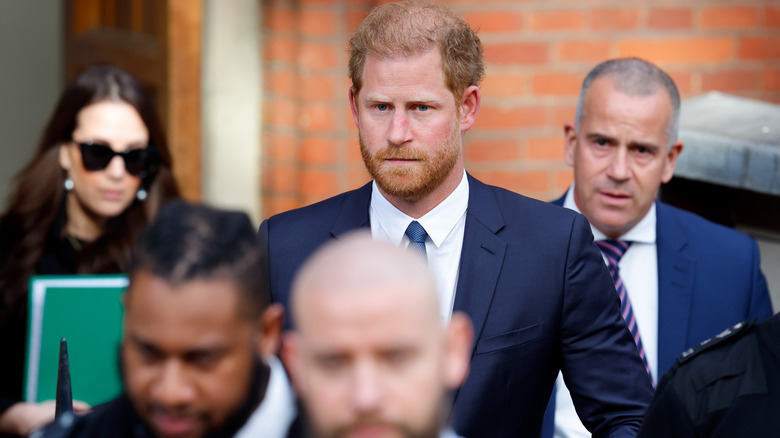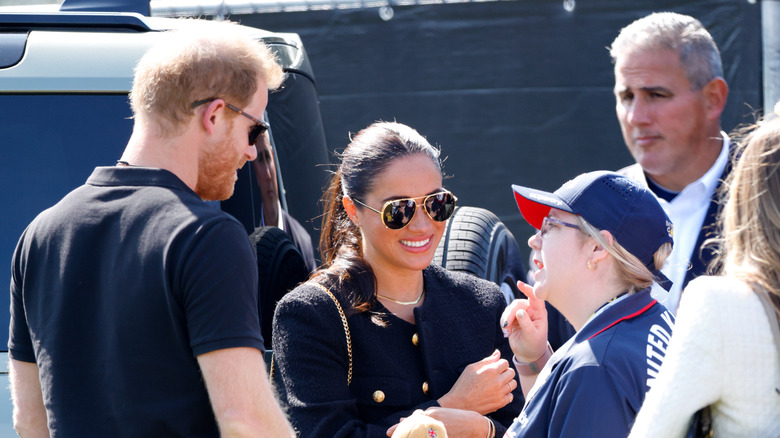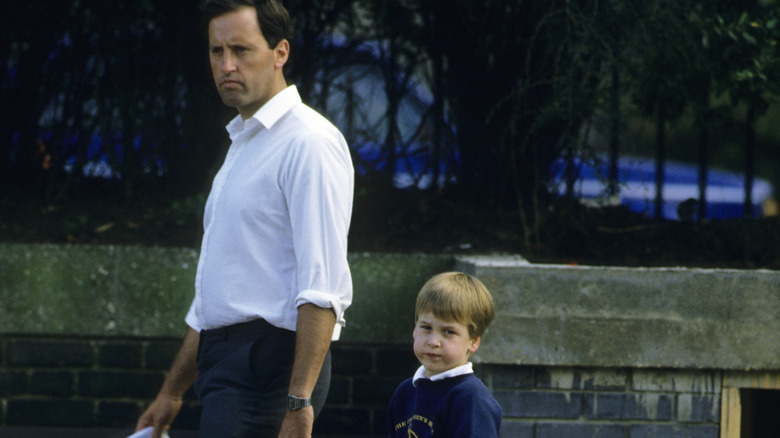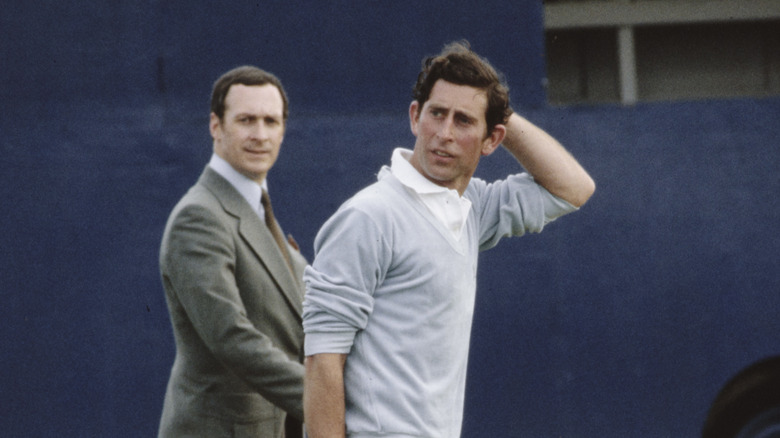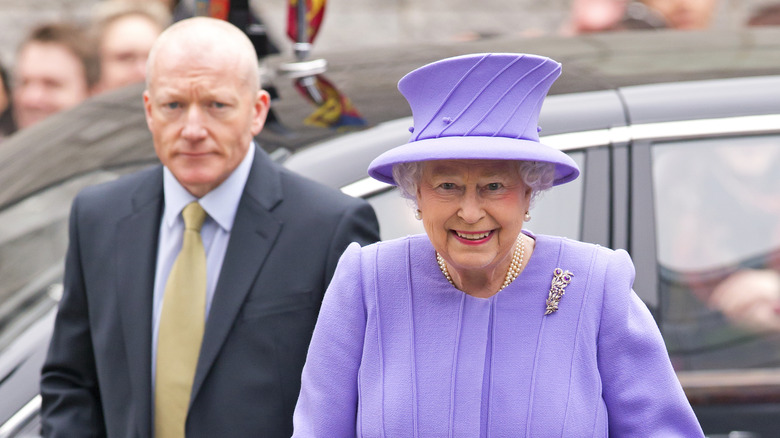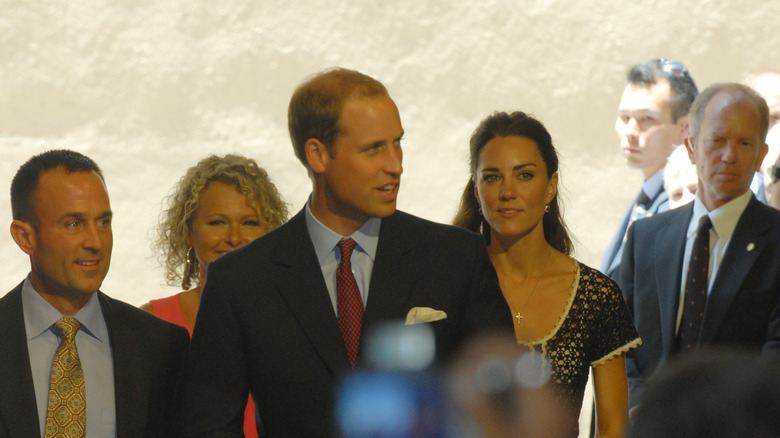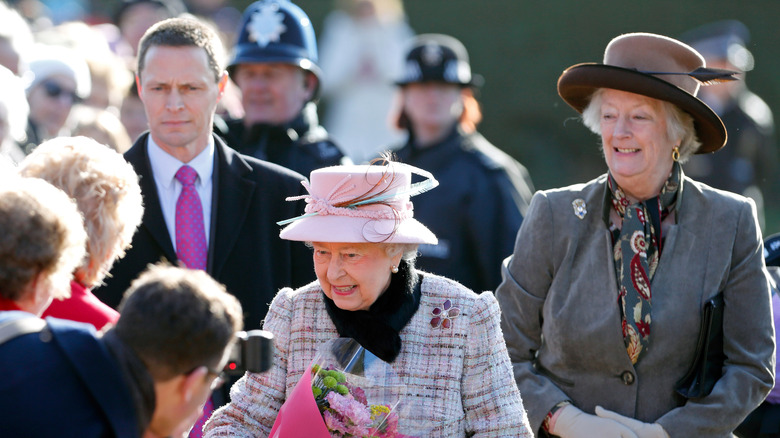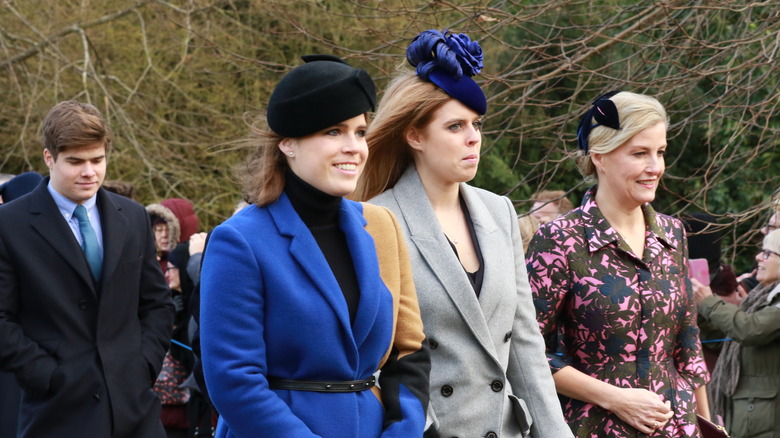Rules The Royal Family Bodyguards Have To Follow
The British royal family are international celebrities, with many people from all over the world fully aware of the ins and outs of their personal relationships and disagreements, thanks to extensive tabloid coverage and dramatizations such as "The Crown." Between their being the immediate family of the British head of state and their status as just extremely famous (and often controversial) people, the higher-ranking (or "senior") members of the royal family require close, around-the-clock security, especially when making public appearances.
This security comes in the form of the Royalty Protection Group, a division of the London Metropolitan Police Service made up of specially-trained personal protection officers, all assigned to provide 24/7 coverage to the king and other select royal family members. What does it take to become one of these elite bodyguards, and what are the rules, requirements, and protocols that such officers have to follow in order to make sure their royal client stays safe?
Have the right training and skills
The Royalty Protection Group is a specialty operation within the Metropolitan Police Service, so step one to becoming a royal bodyguard is being an officer in London's police service. Being chosen for royalty protection is extremely selective, requiring both an intense interview to test personality and temperament, as well as a thorough screening process to confirm that the candidate has the proper experience, training, and skills. Royal protection officers require such basic policing and close protection skills as firearms training, unarmed combat, first aid, advanced driving, reconnaissance, walking formations, protocol, and so on.
More advanced skills required include knowing how to keep your car from being hijacked and tactics to use when in a high-threat environment. But arguably even more important than these physical skills are the interpersonal skills necessary for dealing with celebrities and large crowds. Clear and calm communication capabilities are key, as well as the ability to defuse tense situations, resolve conflicts, have a keen awareness of one's surroundings, and have the flexibility to shift from plan to contingency plan to contingency plan. Knowing when to negotiate and when to remain firm to maintain order is also important.
Some combination of all of these soft skills will be put to use in every single assignment, and the planning for one official appearance by a senior member of the royal family can take months to coordinate. Clearly, patience is a requirement as well.
Carry the right equipment
It's fairly well-known that British police officers do not typically carry guns. While firearms are standard issue for police in the United States, most officers in the United Kingdom are only armed with batons and pepper spray. Some British officers are licensed to carry guns, but only a small number, and only in certain circumstances. Out of a total of almost 35,000 officers in the Metropolitan Police Service, only about 2,600 hold a firearms license. What's more, bodyguards and other close protection service officers are not legally allowed to carry firearms while on the job at all.
The only exception is, as you might guess, officers of the Royalty Protection Group. They are the only bodyguards allowed to carry guns regularly as part of their day-to-day routine, and as a result, they make up a pretty good chunk of those 2,600 Met officers licensed to carry a firearm. The standard-issue weapon is a Glock 17, the standard sidearm of the British armed forces.
In contrast to the Royal Guard — the famous guys who stand in front of the palace in their red coats and tall furry hats — whose job is primarily ceremonial, the everyday members of the royalty protection service dress in plainclothes and are at least slightly more inconspicuous. In addition to the firearms that most royalty protection officers carry, typical equipment includes radios for communication and emergency first aid kits.
Get close but not too close
While individual protection officers are typically attached to a particular member of the royal family — or "principal," in bodyguard talk — on a long-term basis, personnel shake-ups are hardly unheard of. In 2017, for example, a restructuring at the Metropolitan Police saw the Royalty and Diplomatic Protection department merged with Specialist Protection in an attempt to lower the royalty protection budget. This merger resulted in long-serving, higher-paid officers being rotated out in favor of newer officers.
Similarly, in 2021, the Met reassigned a number of protection officers to new principals because they believed that if the officers became too familiar with their principal, they would become too comfortable and familiar, thus lowering their guard. There was also concern that the controlling department, Protection Command, was becoming too cliquish.
The royal family were none too pleased with these personnel changes. A senior source for the royals told The Standard in 2017, "Personal protection is all about building a relationship with the principal. How on earth is that supposed to happen if the officers are rotated every five minutes with new faces?" The officers had formed bonds of trust and a shorthand of communication with their principals, becoming intimately familiar with how they prefer to operate. Rotating in unfamiliar officers only increased the anxiety of members of the royal family. Presumably, then, there is some happy medium between "close" and "too close" that protection officers have to learn to reach: close enough to build trust but not close enough to grow complacent.
Make unimpeachable plans and contingency plans
Despite what you might see in movies, being a bodyguard is not all about cool guns, fast cars, and designer sunglasses. The majority of the job of protecting a member of the royal family goes into preparing for any given event, and being mentally ready for any possible outcome. Rather than simply keeping a cool head in a crisis, the goal of a royal protection officer is to try to prevent crises from arising in the first place.
According to former Royalty Protection officer Simon Morgan (via Estate and Manor Magazine), planning an appearance by a royal can take months, with time taken to reconnoiter the location, meet with the venue, draw up transport routes and parking locations, and so on. Additionally, the protection officer has to think about contingency plans in case of a crisis, imagining just about any possible scenario and what should be done about it.
Every aspect of the plan is checked multiple times, including the physical walking of the route, reviewing the list of planned guests, and clearly communicating with the venue what the security team's needs are. Morgan says that having an airtight plan is essential to not being taken by surprise: as a protection officer, you want to know who and what you expect to see so you're not caught off-guard by the unexpected. Fortunately, he says, these things become second nature over time, even as plans have to be tailored for each specific event and venue.
Don't get caught up in the celebrity lifestyle
Due to their power, influence, wealth, and fame, the British royal family has access to some of the finest and most glamorous places on Earth, and the higher-ranking family members are typically treated like celebrities. As a result, the members of their 24/7 security teams also have access to those places, getting to travel all over the world and eat high-level cuisine as part of their job. However, as cool as that may be, it's not always fun, because they're still very much at work.
Simon Morgan told Business Insider that, while his time as a royal protection officer was significantly more posh than his time as a regular police officer chasing criminals in less-than-royal neighborhoods, he didn't really have the opportunity to luxuriate in the atmosphere. Besides the need to constantly keep watching your principal even if you're eating fancy food, it's crucial to remember that these nice cars and yacht parties are your principal's life, not yours.
Some protection officers became the subject of scandal in 2012 when, while on a trip to Las Vegas with Prince Harry, they became so distracted by partying that they didn't stop other party guests from taking nude photos of Harry (playing strip billiards, naturally), that then got leaked to the press. Additionally, officers who indulge in such celebrity fantasies can become vulnerable to blackmail and other forms of manipulation, creating a security risk themselves.
Don't expect any downtime
The highest-ranking members of the royal family are under armed protection at all times, every hour of every day, and not just at public events and appearances. If you are born into the monarch's immediate family, you have protection from the moment you're born until the moment you die. Even in their private lives, in their own homes, the royals can only ever have the illusion of privacy, as there's always a guard just around the corner. Given the fact that most royals have their preferred officers, one might wonder if royal protection officers ever get any downtime, or if they're literally always at work.
It turns out that they do in fact get days off (which is nice, seeing that a lot of them probably have spouses and children, etc.), but when they're on the clock, there's no such thing as downtime. Even when nothing is happening, the protection officer has to be fully alert. An officer watching a royal on a train, for example, doesn't get to stretch their legs and do a sudoku until they pull into the station.
They have to be mentally prepared for any kind of situation that might arise, so quieter moments are spent thinking ahead or conferring with other team members. The job of a protection officer involves a considerable amount of waiting, even for hours at a stretch, but never any relaxation time. If you've got time to lean, you've got time to devise contingency plans.
Factor in the individual needs of your royal
Besides the need to address the individual challenges presented by each new location where a protection officer accompanies a royal, the bodyguards have to tailor their plans and behaviors to the unique needs of each specific royal member. For example, a child from the royal family has different requirements than an elderly member, and both are different from those of a young adult. Part of reconnoitering an area is being aware of what the closest medical facilities are to any given venue, and if a royal family member has a specific medical condition, it's incumbent upon the protection officer to make sure they know the fastest route to a hospital that can treat such a condition.
Physical needs aren't all that have to be factored in, though. As former Royal Protection officer Simon Morgan told 9Honey, each member of the royal family has their own personality and style of engaging with the public. While the royals themselves are trained from childhood on how to interact with others in a public space, they're still going to want to express their individual selves, and protection officers need to know how to adapt to that, as well as being able to recognize each principal's nonverbal cues and body language.
Morgan gives the example that Princess Anne maintains the older practice of not shaking hands during public appearances, while Prince Harry is often more personable and open to hugs and other physical contact.
Pick appropriate code names
In the U.S., the Secret Service supplies code names to the presidential family and others under their protection. Such monikers have included Rawhide (Ronald Reagan), Timberwolf (George H.W. Bush), and Eagle (Bill Clinton). It will probably not surprise you, then, that the Royalty Protection Group also assigns code names to members of the royal family. Are they as cool and dramatic as the presidential code names? Well, that depends on how you feel about the names Danny, Davina, and Sharon.
Royal family members are given discreet code names that wouldn't look out of place in a person's cell phone contacts. As a result, the code names are usually a regular human name with the same initials as the royal's title. For example, before they became the Prince and Princess of Wales, William and Kate were the Duke and Duchess of Cambridge, so their code names were Danny Collins and Daphne Clark. When Harry and Meghan were still the Duke and Duchess of Sussex, they were David Stevens and Davina Scott. Apparently Queen Elizabeth II was known as "Sharon," or just "S."
There are also special code words used among security to communicate the death of a royal. Queen Elizabeth's death was announced via the phrase "London Bridge is down." The funeral of Prince Philip, Duke of Edinburgh, was referred to as "Operation Forth Bridge." King Charles' death will similarly be referred to as "Operation Menai Bridge."
Be careful with your firearm
While royal protection officers are some of the very few Metropolitan police to be allowed to carry firearms, not every royal bodyguard is equipped with a gun. While most protection officers carry a standard military-issue Glock pistol, starting in 2020, the officers guarding some of the lower-ranking members of the royal family — such as Charles' siblings — had their pistols replaced with Taser stun guns. After Prince Harry and Meghan Markle stepped down as working royals, they likewise lost their right to armed protection, and the private security guards they hire when returning to Britain are not allowed to carry guns.
While it's not common, there have definitely been firearm-related accidents among royal protection officers. In 2000, on a royal train carrying Queen Elizabeth and Prince Philip, a bodyguard accidentally discharged his pistol in a dining car, and then accidentally fired it again while trying to secure it. While no one was injured — and the Queen and the Duke of Edinburgh slept through the whole thing — and minimal damage was done to the train's interior, the officer was taken off firearms duty.
The previous year, another guard accidentally fired his gun while trying to empty it inside St. James Palace, almost hitting a soldier before the bullet ricocheted off the ground and broke a window. While some may debate the efficacy of Tasers as a deterrent or security measure, it seems unlikely they would have put an expensive hole in that train or window.
Determine who qualifies for publicly funded security
Not every member of the royal family gets the same level of personal protection. After all, it's a pretty big family, and as members of the Metropolitan Police, the Royalty Protection Group is publicly funded by taxpayer money. It would be a pretty big budgetary drain for every cousin and nephew to get the same kind of around-the-clock security as the king and queen. Essentially the choice is made at the discretion of the police, based on the perceived threat toward each family member. As of this writing, full-time armed security funded by tax money is provided for King Charles and Queen Camilla, as well as Prince William and Princess Kate and their three children.
King Charles' siblings receive full protection as senior members of the family only when they're working on official royal business — and while attending major events such as royal weddings — but they don't get the same 24/7 coverage as the king and his direct heirs.
Prince Harry and Meghan Markle previously had publicly-funded protection as well, but this was removed prior to their becoming private citizens and no longer working members of the royal family. Similarly, Charles' nieces Princess Beatrice and Princess Eugenie are also considered private citizens — earning money via their own careers rather than being working royals — and do not receive tax-funded protection, with one notable exception: when Beatrice went to study in Switzerland, she was assigned full-time, publicly funded protection.
[Featured image by Mark Jones via Wikimedia Commons | Cropped and scaled |CC BY 2.0]
